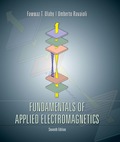
Concept explainers
A remote sensing satellite is in circular orbit around Earth at an altitude of 1,100 km above Earth’s surface. What is its orbital period?
The orbital period.
Answer to Problem 1P
The orbital period is
Explanation of Solution
Given data:
The altitude of satellite from Earth’s surface is
Calculation:
The orbit radius
Here,
Substitute
The conversion of
Hence, the conversion of
The orbital period
Here,
Substitute
The conversion of
Hence, the conversion of
Conclusion:
Therefore, the orbital period is
Want to see more full solutions like this?
Chapter 10 Solutions
Fundamentals of Applied Electromagnetics (7th Edition)
- NO AI. Thank Youarrow_forwardPlease solve in detailarrow_forwardHere the Req is 8 my prof solved it and got R3 is parallel to R4 in series with R2 and this combination is parallel to R1. i don't understand how he got these relationships. initially i did the opposite i took (R1//R4 + R2 ) + R3 but got the wrong answer why is it wrong? can you explain to me if there's a trick i can do to understand these questions better and know the configurations of the resistors in a better manner?arrow_forward
- Here the Req is 8 my prof solved it and got R3 is parallel to R4 in series with R2 and this combination is parallel to R1. i don't understand how he got these relationships. initially i did the opposite i took (R1//R4 + R2 ) + R3 but got the wrong answer why is it wrong? can you explain to me if there's a trick i can do to understand these questions better and know the configurations of the resistors in a better manner?arrow_forwardThe ROC of Laplace transform of x(t) = -e²u(t) + e02tu(t) + e.tu(t) is a) 0.1 0.2arrow_forwardFind the inverse Laplace transform of F(s) = s+1 (s-1)(s-2)(s-3) for each ROC: i) Re[s] =>3 ii) Re[s] =σ<1 iii) 1 < Re[s] =σ< 2.arrow_forward
- Find Laplace transform of x(t) = −e¯btu(−t) + e¯atu(t) (), and Rocarrow_forwardPlease solve in detailarrow_forwardA left-sided signal x(t)=-e¯bt u(-t): 0 == X(s) -e-bu(t)e-st dt =- -Le-c 1 -(b+o+jw)t dt = = -00 -∞ (a + b) + jw 1 s+b For this integral to converge, it is necessary that b +σ <0; i.e., ROC: Re[s]=σ < −b. 2 How ?arrow_forward
 Introductory Circuit Analysis (13th Edition)Electrical EngineeringISBN:9780133923605Author:Robert L. BoylestadPublisher:PEARSON
Introductory Circuit Analysis (13th Edition)Electrical EngineeringISBN:9780133923605Author:Robert L. BoylestadPublisher:PEARSON Delmar's Standard Textbook Of ElectricityElectrical EngineeringISBN:9781337900348Author:Stephen L. HermanPublisher:Cengage Learning
Delmar's Standard Textbook Of ElectricityElectrical EngineeringISBN:9781337900348Author:Stephen L. HermanPublisher:Cengage Learning Programmable Logic ControllersElectrical EngineeringISBN:9780073373843Author:Frank D. PetruzellaPublisher:McGraw-Hill Education
Programmable Logic ControllersElectrical EngineeringISBN:9780073373843Author:Frank D. PetruzellaPublisher:McGraw-Hill Education Fundamentals of Electric CircuitsElectrical EngineeringISBN:9780078028229Author:Charles K Alexander, Matthew SadikuPublisher:McGraw-Hill Education
Fundamentals of Electric CircuitsElectrical EngineeringISBN:9780078028229Author:Charles K Alexander, Matthew SadikuPublisher:McGraw-Hill Education Electric Circuits. (11th Edition)Electrical EngineeringISBN:9780134746968Author:James W. Nilsson, Susan RiedelPublisher:PEARSON
Electric Circuits. (11th Edition)Electrical EngineeringISBN:9780134746968Author:James W. Nilsson, Susan RiedelPublisher:PEARSON Engineering ElectromagneticsElectrical EngineeringISBN:9780078028151Author:Hayt, William H. (william Hart), Jr, BUCK, John A.Publisher:Mcgraw-hill Education,
Engineering ElectromagneticsElectrical EngineeringISBN:9780078028151Author:Hayt, William H. (william Hart), Jr, BUCK, John A.Publisher:Mcgraw-hill Education,





